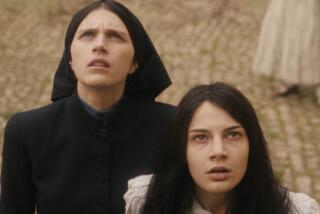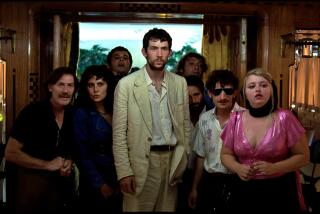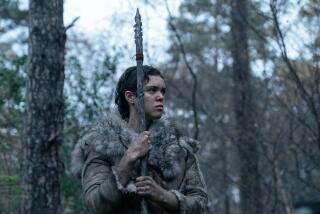Director cloaks ‘The Witch’ in period details to immerse cast and viewers

Call it artisanal horror, driven in part by the same impulses that have modern consumers hungering for old-fashioned food preparations based on a respect for handmade, small-batch craftsmanship. “The Witch” is a film that attempts not to simply mimic a world of primitive technology, superstition and beliefs, but rather to conjure it completely.
The feature debut for writer-director Robert Eggers, “The Witch” which opens Friday, is set in the 17th century and opens with a family being banished from a colonial community in a clash over religious beliefs.
As they struggle to survive on a remote plot of land near a forest and one setback after another befalls them, the parents (played by Ralph Ineson, Kate Dickie) become increasingly convinced that their teenage daughter Thomasin (Anya Taylor-Joy) has turned to witchcraft.
Working with production designer Craig Lathrop, costume designer Linda Muir, cinematographer Jarin Blaschke, editor Louise Ford and composer Mark Korven, Eggers has created a boldly convincing version of New England farm life circa 1630.
Eggers spent four years researching, writing and finding financing for the film, and in conversation he easily slips into detailed explanations of the religious distinctions among various Puritan colonies, the differences in witchcraft folklore between France, Germany, England and New England or the evolution of events that led to the Salem witch trials some 60 years after the time of “The Witch.”
“I am positive it is the most accurate portrayal of this period in American history on screen. We went to such lengths to make it so,” Eggers said in a recent interview. “Everything with the farmstead that we built, everything that you see on-screen is made from the correct building materials that would have been used at the time. Most often we used the traditional tools and techniques to create these objects. And the clothing is hand stitched based on extant clothing.”
For the actors, that level of hyper-consideration of sets and clothing made stepping back in time that much more convincing and the atmosphere of story that much more intense.
“Robert made a world for us and we just went into it every day,” said Taylor-Joy. “And having him around was just this wall of information. It’s all so specific. We knew the world and really committed to it and so hopefully the audience will too.”
When the film premiered at the 2015 Sundance Film Festival, it played as part of the prestigious main competition section, still a rare spot for a horror film, no matter how authentic. Eggers picked up a directing prize at the festival, a nod to the totalizing vision of the world in the film.
It would be easy to portray the film’s attention to detail as either fetish or affectation, yet for Eggers it served a specific emotional idea.
“The purpose of it in this film is to bring audiences back to the 17th century. You have to believe in the world,” he said. “For me it needed to be so personal, that I’m articulating my memories, my particular childhood when my father took me into the cornfield and the way he smelled that morning and the way the mist was over the corn. And if we didn’t know how to do it right I can’t be that specific and share a memory. Maybe that sounds a little precious but I feel like it is that kind of personal detail that makes the film transportive.”
In a bold move, the film’s distributor A24 is giving it a national release instead of a more limited opening in selected cities.
Rather than other horror movies, “The Witch” has been garnering comparisons to the work of such auteurs as Stanley Kubrick and Ingmar Bergman — whom Eggers jokingly calls “the old dead canonical European art house directors.”
For the most part, critics have responded strongly to the film.
In Time, Stephanie Zacharek noted “‘The Witch’ has been made with extreme care, and part of what makes its supernatural elements so terrifying is that Eggers is also in tune with the more ordinary challenges of just being human.”
At Slate, David Ehrlich called the film “a bracingly new experience that boils with the primordial fever of America’s original sins.”
Besides announcing Eggers as a new and unique filmmaking voice, the film also introduces Taylor-Joy, 19, as a talent to watch in her first major film role. Born in the U.S. but raised in Argentina and England, she was living in London when she put herself on tape to audition for the part.
“I imagined Thomasin a little differently, but then as soon as Anya auditioned it was clear she was going to be Thomasin,” said Eggers. “On-screen she has this very enigmatic quality where you’re very drawn in to her, you want to know what she’s thinking and you don’t know. And that was really crucial to the character. Even in the auditions, the way she delivered the dialogue was how I imagined it. It seemed to make sense.”
Taylor-Joy recalled the unsettling feeling of first reading the script.
“The script itself is atmospheric. I’d never read anything like that before,” she said.
“It’s like someone dropped a bomb of glitter in the pit of your stomach and you don’t really know how to feel about it. It’s something you don’t understand and you know you don’t need to understand it yet. It’s like an instant instinct.”
Whether there is a witch in “The Witch” is something for audiences to discover, as much of the story deals with the family’s internal dynamics as to how to deal with their most immediate problems — a missing infant, dying crops, an impertinent goat named Black Phillip. The story could be read as an allegory for adolescence, as Thomasin discovers her powers as a young woman and sees the reactions she begins to draw out from others.
“I want people to be able to find their own interpretations of the film, but it’s definitely a coming of age story for Thomasin,” said Eggers. “But I didn’t set out to write a coming of age story. I set out to write a Puritan nightmare, a nightmare from the past, something that would portray witchcraft in the way a lay family in New England would have seen it.”
Eggers is originally from New Hampshire but lives in Brooklyn, where he began his career working as a designer and director in theater with an eye toward directing in film. That mix of rural innocence and urban knowingness, an attention to detail with a sense of the larger emotional meaning, is what give the film much of its power.
“My earliest dreams I can remember were nightmares about witches. Salem and the lore of New England witches was always something that interested me,” he said.
“So this felt like a genre film I could make very personal to me.”
Twitter: @IndieFocus
More to Read
Only good movies
Get the Indie Focus newsletter, Mark Olsen's weekly guide to the world of cinema.
You may occasionally receive promotional content from the Los Angeles Times.







